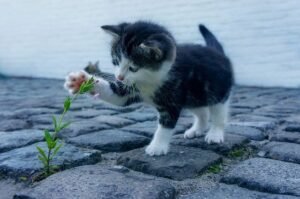Cat
The cat, who is a pet animal, is one of the most common animals in the world. Being the only domesticated species in the family Felidae gives any cat the ability to be in farms, or even homes. The cats, which are small carnivorous mammals, are appreciated by people as they kill rodents and can be great companions. There are almost sixty cat breeds, and most of them can be great as pets.
The cat has retractable claws, sharp teeth, quick reflexes, and a powerful flexible body making them able to kill small prey like birds and mice. The cat, who is known for having a great sense of smell and night vision, can communicate with vocalizations such as grunting, growling, hissing, trilling, purring, and meowing. The most active period of any cat is dawn and dusk when they usually hunt. The cats also have great ears as they can hear sounds, that are too high or too faint for humans like what mice make. They also perceive and secrete pheromones.
Female cats, in general, can get pregnant and have litters containing 2-5 kitties from spring to late fall. Neutering and Spaying may affect the population of cats.

Domestication
Domestication of cats first started around 3100 BC in ancient Egypt, but it is believed that the domestication started around 7500 BC in the Near East. However, there are now almost 480 million homeless cats and almost 220 pet cats. With almost 96 million pet cats, this animal was the 2nd-most common pet in the US in 2017. Whereas in the UK, there were almost 11 million pet cats in 2020.
Characteristics
Balance
There is a noted fondness for perching in high places or sitting. Domestic cats generally sit on higher places like a tree branch to have a great vision for hunting. However, cats can survive fallings up to 9.8 ft (3 meters). Furthermore, cats land on their feet by twisting the body using their acute sense of flexibility and balance during a high-place fall. This feature is called the cat righting reflex. However, the “falling cat problem” is the name of the cats’ ability to twist themselves during falling. They should have enough time to be able to twist their bodies, which is 2’ 11” (90 cm) or more.
Ambulation
The cat moves 2 legs of the same side before using its 2 other legs, which is known as a “pacing gait”. However, cats are not like most mammals as they walk on their toes trying not to make noise! Furthermore, when they run, they use a “diagonal” gait: forelegs move in a simultaneous way, and opposite hind move in a diagonal way.
Claws
In cats’ relaxed position, which is normal, their claws, which are retractable and protractible, are sheathed with the fur and skin around the toe pads of the paw. This lets them stalk the prey silently and prevent wear from contact, which keeps the sharpness of the claws. Furthermore, the claws on the hind feet are not as sharp as they are on the forefeet. Cats also have the ability to extend their claws. However, they can use this ability in many things such as kneading, climbing, self-defense, or hunting. Most cats have 4 claws on their rear paws and 5 on their front paws.
Skull
The cat has a usual skull compared with other mammals as it has a powerful specialized jaw and so large eye sockets. The cats’ teeth are sharp enough for tearing meat and killing prey. The first molar and premolar are like scissors as they shear meat into little pieces! Despite having better teeth than most human beings, cats’ teeth are less liable to decay due to a diet mostly devoid of sugar, less retention of food particles between teeth, less damaging saliva, and a thicker protective layer of enamel. However, they are also liable to lose teeth or get infected.
Skeleton
Each cat has a variable number of caudal vertebrae in the tail, 3 sacral vertebrae, 7 lumbar vertebrae, thirteen thoracic vertebrae, and 7 cervical vertebrae. The extrathoracic and lumbar vertebrae account for the cat’s spinal flexibility and mobility. The pelvis, shoulder, and 13 ribs are attached to the spine.
Size
The European wildcat has a bigger skull and taller bones than the domestic cat. The head-to-body length of the domestic cat averages about 18” (46 cm), with about 12” (30 cm) long tails, and 9-10” (23-25 cm). However, females are smaller than males. Furthermore, the weight of an adult domestic cat is typically 9-11 lb (4-5 kg).
Share this to let other people know about it!
